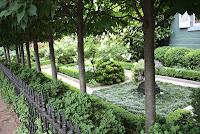Dumbarton Oaks - a Treat for Garden-Tourists
Dumbarton
Oaks, R and 31st Streets, Georgetown, Washington D.C.
Gardens open March 15 through October 31, from 2:00 p.m. until 6:00 p.m. and
from November 1 through March 14, open 2:00 p.m. until 5:00 p.m. Closed Mon.
Gardens open March 15 through October 31, from 2:00 p.m. until 6:00 p.m. and
from November 1 through March 14, open 2:00 p.m. until 5:00 p.m. Closed Mon.
-----------------------------------------------------------------------------------------
The gardens at Dumbarton Oaks were designed by American landscape architect,
Beatrix Farrand (www.beatrixfarrandgarden.org) who worked 20-years on the
design with the property owners, Mildred and Robert Woods Bliss.
Though
few of her gardens survive today, Farrand (1872-1959) received over
200-commissions during her 50-year career. Her clients included families on the
east coast, the New York Botanical Garden, the White House, and universities.
Farrand
was the fifth generation in her family to become gardeners and landscape
professionals. After her marriage at age 20, Farrand studied landscape
gardening, botany, engineering, elevation rendering and other courses at Columbia
University since there were no landscape architecture majors at the time. Her
aunt was Edith Wharton and Henry James was a lifelong friend.
Part of
her education included traveling and sketching famous gardens around Europe.
Her signature design of garden rooms, so common today, came from visiting English
and Italian Renaissance gardens. The design of Dumbarton Oaks in
Georgetown/Washington D.C. is considered to be her masterworks and is one of
the best for garden-tourists to visit.
Farrand
also established a landscape study center in Maine where students learned from
demonstration gardens, herbarium and research library. At the end of her life,
U.C. Berkeley received her professional papers and collections.
Dumbarton
Oaks (www.doaks.org) celebrated the 100-year
anniversary of the garden in 2012 with restoration projects and history
programs.
Farrand’s
focus on native plants, influenced by her study and travel, is evident in all
her works, including Dumbarton Oaks. Within each of the garden rooms, plants
and garden ornaments define the rooms' character and use.
Trees
are used as centerpieces, as frames for a view, or to enclose a space. For
example, on Crabapple Hill a combination of Crabapple (Malus), Asiatic apple
(spectabilis), Japanese flowering crabapple (floribunda) and Siberian crapapple
(baccata) are used. Evergreen shrubs such as Privet (Ligustrum), Boxwood
(Boxus) and Canadian hemlock (Tsuga Canadensis) are used as screening.
Benches
have been placed into corners, under arbors, in fountain-viewing spaces and
around shrub rows. Decorative items such as urns and large vases are placed
where they serve as focal points.
Dumbarton Oaks has two herbaceous borders
that run parallel for 200-feet. They are filled with annuals and perennials and
are edged with columnar-shaped Hicks Yew (Taxus baccata Hicksii) hedges. Iris yew shrubs (Taxus baccata
Fastigiata) create walls at both ends with a male Mr. Yew at one end and female
Mrs. Yew at the other, forming a separate room with 4-benches that Farrand
designed.
Farrand
specified that the flowers inside this garden must be shades of pink, red,
lavender and pale blue. As requested, the borders contain tulips and pansies in
the spring and end with chrysanthemums and asters in the fall.
The
Lover's Lane Pool is a garden theater that was modeled after an open-air
theater located in Rome at the Accademia degli Arcadi Bosco Parrasio. It also
resembles the reflecting pool in the middle of the Orangery at Versailles.
There is a Versailles-like vista of manicured lawn visible from the house, though
Farrand added trees and French Stairs to set her design apart.
Paths
take visitors through many gardens including: children’s garden, fountain
terrace, box terrace, rose garden, pebble garden, beech terrace, woodland,
orangery, etc. (www.bloomingatdoaks.com).
 |
| http://harvard-dc.org |
Plan to
visit the museum while you are there. The galleries contain a memorable collection
of Byzantine and Pre-Columbian art plus European masterpieces, as well as
rotating special exhibits. The collections were started by Mildred and Robert
Woods Bliss and have been continued by the current owner, Harvard University.
Every
month there are free events such as architecture walks and art lectures. Check
the website for details.
Dumbarton
Oaks has no parking but there is public transportation (http://wmata.com/rider_tools/tripplanner/tripplanner_form_solo.cfm). We found street
parking.
For other things to do while in D.C. check http://www.doingthedistrict.com/.







Comments
Go to that site with the dates of blooms and find the time that your favorites are flowring.
Then, don't miss the museum. It's a remarkable treasure.